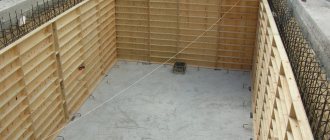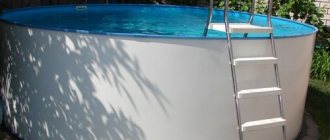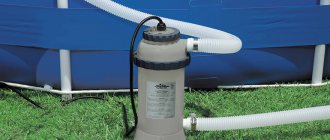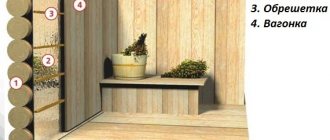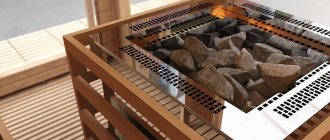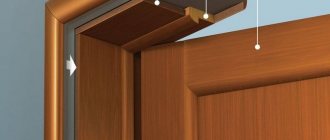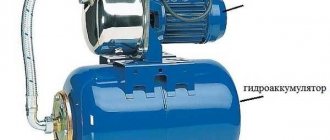The water in the pool needs to be at a comfortable temperature, all the time. No direct-acting heater can heat such a large volume of liquid, and evenly. It is necessary to warm up a large volume of water and constantly replenish heat losses, which in a pool are considerable only due to the large surface area. The heat source can be a heating boiler, solar panels or geothermal heat, and to transfer the heat to the water you will need a pool heat exchanger.
The easiest way to heat a pool is to place a heat exchanger in series with filters and a circulation pump, which constantly pumps liquid from the bottom drain and skimmer and returns it back through the nozzles located around the perimeter of the bowl. Thus, the water in the pool does not stagnate and is regularly cleaned and heated. There is no additional equipment in the tank itself; everything is taken outside of it and is most often placed below ground level in a special caisson.
Heat exchanger for a swimming pool: operating principle and power calculation
The water in the pool needs to be at a comfortable temperature, all the time. No direct-acting heater can heat such a large volume of liquid, and evenly. It is necessary to warm up a large volume of water and constantly replenish heat losses, which in a pool are considerable only due to the large surface area. The heat source can be a heating boiler, solar panels or geothermal heat, and to transfer the heat to the water you will need a pool heat exchanger.
The easiest way to heat a pool is to place a heat exchanger in series with filters and a circulation pump, which constantly pumps liquid from the bottom drain and skimmer and returns it back through the nozzles located around the perimeter of the bowl. Thus, the water in the pool does not stagnate and is regularly cleaned and heated. There is no additional equipment in the tank itself; everything is taken outside of it and is most often placed below ground level in a special caisson.
Principle of operation
The heat exchanger itself does not heat the water. It is only an optimized device for effective heat exchange between two media. One of them is the coolant from the direct heat source, and the second is just water from the pool.
In a heat exchanger, the two media are separated only by thin walls of pipes or plates with high thermal conductivity. The higher the area of such contact, the more heat will have time to transfer from the hotter liquid to the colder one.
In essence, the heat exchanger is always in-line, although the volume of chambers and sections for pumping two media may differ significantly. Tubular and plate heat exchangers are used for swimming pools. The advantage is on the side of tubular devices, since they reduce the resistance to water flow introduced by the device and are less demanding on the purity of the pumped liquid.
The housing forms the first chamber for the heated liquid. This is an oblong cylinder made of a large diameter pipe, closed at both ends with plugs that have fittings for connecting pipes. It is insulated on top to eliminate unnecessary heat loss.
Tubes are distributed inside the housing, isolated from the internal space of the device, with fittings located on the outside. The tube can be one curved in a spiral to increase the contact area and stretching from one edge of the heat exchanger to the other. But it is more efficient to use many tubes in parallel, which are connected at the ends by a manifold. This significantly reduces the hydraulic resistance of the heat exchanger to the coolant circuit and increases the contact area and boundaries between the two liquids.
Main characteristics of the heat exchanger:
- Maximum operating temperature. The maximum heating of the coolant that the device can withstand.
- Thermal power. It depends not only on the contact area, but also on the type of liquid in both circuits and the temperature difference.
- Throughput, measured in cubic meters per hour, determines how long it takes the entire volume of the pool to pass through the heat exchanger.
Power calculation
The selection of heat exchanger power for a swimming pool is carried out based on four factors:
- Size of the pool, volume of constant heat loss;
- Coolant temperature and heat source power;
- Target pool water temperature;
- The time it takes to heat water, provided that it has just been filled.
The goal is not to heat the entire volume of water in the pool bowl as quickly as possible. The heat exchanger capacity is sufficient at a level equal to the maximum constant heat loss so that the temperature can be maintained at a given level.
The lower limit for power selection is taken to be approximately 0.7 of the volume of the pool bowl, or more precisely, water when completely filled. This is an approximate value of heat loss due to evaporation and heat exchange with the walls of the bowl.
Exceeding this threshold determines the time during which the heat exchanger can warm up only the collected cold water and most often this parameter is set to 1-3 days.
A heating boiler is used as a heat source, working both to heat the house and to heat the pool, or in a small circuit only to heat the pool, for example during a warm period of time. The maximum possible heat output should be determined precisely under the conditions of heating operation in the house, so as not to take away excess heat to maintain the pool.
Required heat exchanger power to heat the pool in a certain time.
P = ((V*С * ΔТ)/t1) + q*S
Where:
P – required heat exchanger power (W),
C – specific heat capacity of water at a temperature of 20°C (W/kg*K);
ΔТ – difference in temperature of cold and hot water (оС),
t1 – optimal time for heating the entire pool (hours),
q – heat loss per hour per square meter of water surface (W/m2),
V – volume of water in the pool (l).
Calculations should take into account heat loss from the water surface due to evaporation. The following values are accepted:
- The pool is completely outdoors - 1000 W/m2.
- Partially covered by a canopy or part of a building - 620 W/m2.
- Fully indoor pool – 520 W/m2.
The obtained value is exactly the parameter that you should first focus on when choosing a heat exchanger. The remaining parameters must be coordinated with the existing equipment.
If you want to divide the operating time of the heat exchanger into night and day, when an electric hot water boiler is used, the power of the heat exchanger must be increased accordingly. It is enough to multiply the previously obtained number by 24 and divide by the number of hours that are supposed to be allocated for heating the pool.
The resistance to water flow should be taken into account when choosing a circulation pump, moreover, together with the filter station, the resistance of pipes, nozzles and all other piping elements.
The maximum permissible temperature in the hot circuit is determined by the nominal temperature produced by the boiler or heating boiler.
From the same formula it is easy to derive the heating time of the pool, knowing the power of the commercially available heat exchanger. There is no need to chase ultra-fast heating; it is enough if the pool warms up from a completely cold state to a comfortable temperature in two days.
Connection
Connection diagram
The heat exchanger is turned on after the filter and circulation pump, but before the dispenser for chemicals, chlorine, fragrance, etc. Connections of both circuits are made only through shut-off valves to allow control of switching on and dismounting for maintenance purposes.
The heating must be controlled by a control valve located at the hot circuit supply from the boiler. It, in turn, is regulated by a thermostat head, in which the temperature sensor is fixed to the outlet pipe of the heated circuit. Using a stationary immersion thermometer with indication, the thermal head settings are set to control the coolant supply.
The heat exchanger for the pool should be installed below the pressure line, in fact below the pipes connected to it, below the filter and air vent, eliminating the ingress and accumulation of air.
Most often, the circuit from the heating boiler to the pool and heat exchanger turns out to be extended. Therefore, an additional circulation pump is installed on the line. For its smooth operation, a bypass should be arranged parallel to the heat exchanger and in front of the control valve. As a result, the heat exchanger constantly monitors the temperature of the pool water and heats it up if necessary.
Source: https://udobnovdome.ru/kak-vybrat-teploobmennik-dlya-bassejna/
How to speed up the heating process?
To speed up the water heating process, it is necessary to reduce heat loss as much as possible . One effective way is to install a heat-saving coating on the water surface. A special film will stop the process of evaporation of warm layers of water rising to the top, which will reduce losses and accelerate the rise in temperature.
Another option is to use high-performance heaters that have power reserves for a bowl of a given size. This is important for public swimming pools, where it is not possible to stop using the bowl and wait for the water to heat up to the standard value.
Usually the equipment is run at full capacity in order to get the desired result in the shortest possible time.
Heat exchanger for a swimming pool: rules for selection and features of do-it-yourself assembly
The most important condition for comfortable use of a swimming pool is high-quality water heating. But how can this be ensured, given the large volumes of liquid used and the high heat loss of an artificial reservoir? The most reasonable solution is to systematically exchange water at different temperatures: cold and hot.
This process can be organized using a heat exchanger.
To understand the features of this heating option, we suggest taking a closer look at the main operating device - we’ll tell you what a heat exchanger is, what to look for when choosing it, how power is calculated, and how to make and install the device yourself.
Structure and principle of operation
Structurally, a pool heat exchanger is a cylindrical body with two circuits: in the first, which is the immediate cavity of the device, liquid from the pool circulates, and in the second there is a device through which the coolant - hot water - moves. Either a tube or a plate acts as a device for heating the liquid.
The heat exchanger itself does not provide water heating - with the help of external fittings of the second circuit, it is connected to the boiler of the heating system and acts as an intermediary in heat transfer: first, water enters the device from the pool, then it moves along the body, comes into contact with the heating device, and takes from it the heat and then, already heated to the required temperature, returns back to the bowl. The larger the contact area of the heating element, the faster the heat transfers from hot water to cold.
How does a pool heat exchanger work?
Selection factors
When choosing a heat exchanger, take into account the following characteristics:
- Type of heating device: tubular or plate.
Advice. Experts recommend choosing tubular heat exchangers, as they provide a larger area of contact with water and are less sensitive to the quality of the circulating fluid.
- Bandwidth.
- Case material: stainless steel, plastic, titanium.
- Type of heater to which the heat exchanger will be connected: gas or electric boiler.
- Thermal power.
The last characteristic is the most important, because it significantly affects the performance of the heat exchanger. Based on this, a logical question arises: how to calculate the power of the device for your pool? For simplified calculations you will need the following data:
- V – bowl volume (l);
- ΔT – the difference between the required temperature of the heated water and the base temperature of the water in the pool (degrees);
- t1 – expected water heating time (hours);
- C – specific heat capacity (always equal to 1.16);
- q – heat loss from the water surface (W/sq.m.)
Important! Average heat loss rates: for an outdoor pool - 1000 W/sq.m., for a partially indoor pool - 620 W/sq.m., for a fully indoor pool -520 W/sq.m.
Calculation formula: P = ((VхСхΔТ)/t1) + qхS
Let's assume that you have at your disposal a fully open swimming pool with a volume of 40 liters and a water surface of 24 sq.m. To heat water in it in 4 hours, subject to a temperature difference of 15 degrees, you will need a heat exchanger with an approximate power of P=((40x1.16x15)/4)+1000x24 = 24 kW.
Manufacturing and installation
If for some reason you do not want to buy a heat exchanger for your pool, you can build it yourself. To do this, prepare:
- steel cylindrical tank;
- copper pipe;
- power control device;
- anode.
Heat exchanger connection
First, make two holes at the ends of the tank: the inlet for the flow of cold water from the pool, the outlet for the return of heated liquid. Then roll the copper tube into a spiral-like structure. Fix the resulting heating element in the tank and bring both of its ends to the outside of the container, having previously made appropriate holes in its walls. Next, connect the power regulator to the tube and install an anode in the tank - it will protect the container from temperature changes.
Now you need to connect the heat exchanger. It should be installed after installing the pump and filter, but before attaching various types of dispensers. As a rule, the heat exchanger is located below all pipes, filters, and air vent.
The device is mounted in a horizontal position: the inlet and outlet of the tank are connected to the pool circuit, and the inlet and outlet of the heating tube are connected to the coolant circuit from the heating boiler. The easiest way is to use threaded connections. All connections are made using shut-off valves. After the circuits are connected, a control valve with a thermostat is installed at the coolant inlet pipe from the boiler, and a temperature sensor is installed at the water outlet into the pool.
Advice. If the circuit from the heating boiler to the heat exchanger is too long, install an additional circulation pump in its line to ensure uninterrupted operation of the system.
As you can see, a heat exchanger is a simple but very useful device that can guarantee uniform heating of water in a pool of any volume. You can buy an already assembled device, or you can make it yourself - in both cases, follow the above recommendations to accurately get the desired result: always warm and comfortable water in your pool.
Heat exchanger for a swimming pool: photo
Source: https://sandizain.ru/na-dache/vodnye-sooruzheniya/teploobmennik-dlya-bassejna.html
Connection
The heat exchanger is installed strictly after the circulation pump and filter. A reagent dispenser is mounted behind it. Changing the installation order is not permitted.
The node must be located below all other elements to prevent air from entering the circuits. There is a valve in front of the device that regulates the supply of liquid and is connected to a temperature sensor. This allows you to automatically adjust the heating.
Professional installation and maintenance of pool heat exchangers - BigPul
A pool heat exchanger is a device that transfers heat from a hot medium to a cold medium. It is indispensable for comfortable use of the pool. All heat exchangers have a cylindrical shape, inside which there are two circuits where water circulates from cold to hot.
Basic operating rules
The efficiency of the plate unit reaches 90–95%. However, scale is actively deposited on the walls. Therefore, to heat water, its hardness must be softened.
The hydrogen activity of the liquid pH should be in the range of 7.4–7.6. It needs to be monitored every day. You also need to remove debris and leaves from the water - their rotting increases the pH.
The filters must not be damaged by debris getting into the pipes. Chlorine is added in more than one place and mixed thoroughly.
If these rules are violated, accelerated damage to the heat exchanger occurs.
Heating the pool water
Heated swimming pools are a pleasure at any time of the year and in any climatic conditions. One of the important elements in swimming pool equipment is water heating.
The ability to regulate and maintain the desired water temperature creates additional advantages of using a pool: for optimal physical activity, a constant water temperature of 27 degrees is required, while for the greatest relaxation effect, for hydrotherapy or massage, the pool needs to be heated to 30-33 degrees.
In addition, it should be remembered that at the same temperature of the pool water and air, cooling in water occurs approximately 20 times faster than in air.
First you need to decide how the pool will be heated. There are two types of pool heaters. This is an electric heater and heat exchanger. Since we will still need to make some choice, we will consider the pros and cons of each, and then select what we need.
View water heating equipment in our store.
Electric heaters
Flow-through electric heaters are used to heat water in swimming pools. The heater is a flask made of materials that are slightly susceptible to corrosion. This is stainless steel, titanium or plastic. Electric heating elements are located inside the flask. There are 2 threaded holes on the outside for water inlet and outlet.
Water from the pool, flowing through the electric heater, gradually heats up to the required temperature during operation of the filtration equipment. The electric heater has a temperature regulator.
To protect the electric heater from emergency situations, an overheat sensor, flow sensor or pressure sensor is provided.
The advantages of installing an electric heater are probably the ease of installation. After all, in order to heat a pool standing, for example, on the street or in a separate room, you do not need to think about thermal calculations, the supply of coolant, etc. The disadvantages, and very significant ones, are of course the price of the electric heater and the price of electricity.
In addition, it is not always possible to supply the necessary electrical power to the pool. Such heating is relevant only in small pools, such as, for example, prefabricated pools, or pools with a volume of up to 15 m3.
Of course, if there are no problems with electricity, then you don’t have to read all this, but immediately move on to selecting the required heater.
Electric heater calculation
Calculating and selecting any heater for a pool is not easy. And indeed it is. Only specialists in this matter can make a detailed thermal engineering calculation, taking into account all the nuances and pitfalls. But we will simplify the task. We will leave exact calculations for public swimming pools.
The volume of our pool is 27m3. For an indoor pool we take 1/3 of this figure, we get: 9 kW of electrical power.
The parameters of electric heaters from almost all manufacturers are the same. 3,6,9,12,15,18 kW. We got exactly 9 kW. But if this does not work out, for example, when dividing it turns out to be 9.3 kW, then we select the heater next to 9 kW - this is 12 kW. This will allow you to take into account possible heat loss and quickly heat the water to the required temperature.
For an outdoor pool, everything is almost the same, only we divide the volume of the pool in half. In our case it is 13.5 kW. Moving forward to more and getting 15kW. It's simple.
Heat exchangers
Water-to-water heat exchangers are used to heat water. The heat exchanger is still the same flask, only there are 4 holes in it, and 2 independent circuits. Along one circuit, actually through the flask, water from the pool moves, along the other, located in the heat exchanger body in the form of a spiral or tubes, the coolant from the boiler moves, heated to 90C. The water flow, intersecting with the hot spiral of the coolant circuit, is gradually heated to a certain temperature.
To ensure that the plastic pipes around the pool connected to the heat exchanger do not overheat due to the filter unit pump stopping, additional equipment is installed on the heat exchanger. These are a circulation pump and a solenoid valve.
The circulation pump is installed at the coolant outlet from the heat exchanger, on the “return”, and the solenoid valve is installed at the coolant inlet, on the “supply”.
The filtration control unit controls the operation of this water heating system. If the water temperature has dropped, the solenoid valve opens, the circulation pump turns on and the coolant moves through the heat exchanger.
As soon as the water is heated, the circulation pump turns off, the valve closes, and the coolant stops. The temperature sensor can be installed directly in the heat exchanger, or separately in the piping before the heat exchanger.
What determines the speed at which the bowl warms up?
The time it takes to warm up the water depends on several factors:
- Bowl size, water volume. The more water, the longer the heating process and the more powerful the heating elements must be.
- Heating method.
- Bowl material.
- What age group is the pool intended for (water in children's bowls, according to standards, should be warmer than in adult pools).
- Location of the pool (indoors or outdoors). Indoor heating occurs faster, since there is no loss of thermal energy dissipated into the environment.
The heating time also depends on the required temperature:
- For adults - 23-25°.
- For children under 7 years old - at least 32°.
- For children aged 7 years and older, 29-30° is required.
- For a jacuzzi or hot tub - 35-39°.
These values are conditional, since each owner independently determines the most comfortable water temperature in his pool.
What materials are they made from?
For swimming pools filled with fresh water, heat exchange units are made of stainless steel. Stainless steel does not release iron ions, so it does not turn the pool water dark. It can easily withstand thermal shocks and can be easily repaired if necessary.
The chemical composition of stainless material is quite inert, so a heat exchanger made of anti-corrosion steel will last at least ten years before major repairs. And the main advantage of the material is its relatively low cost compared to other (not subject to corrosion) structural materials.
If the pool tank is filled with seawater, then the heat exchanger made of stainless steel will not last long. Titanium heat exchangers are manufactured for such operating conditions. Structural titanium:
- chemically passive (practically does not oxidize and does not react with chlorine, fluorine, and various salts);
- has high temperature resistance;
- lightweight and durable.
The performance characteristics of titanium fully compensate for its significant cost.
Introduction
According to the current sanitary and hygienic rules SanPiN 2.1.2.1188-03, the temperature of the water contained in the bowl of sports swimming pools should be within 24-28°C. And in the pools of water parks that accept visitors under seven years of age, they are required to heat the water to 30-32°C. Due to the physical characteristics of water, maintaining the above-mentioned temperature conditions without using additional heating equipment is quite difficult. Therefore, both large sports complexes and large water parks widely use recuperative heat exchangers for pools, with the help of which they heat the water to a temperature that is comfortable for humans.
Other methods of heating an artificial reservoir
Let's look at what devices can be used to heat the water in the pool.
Geyser
The water in the pool can be heated using a household gas water heater .
However, it must be taken into account that this method is only suitable for small-volume remote pools. They are installed on a temporary basis at dachas or on the territory of a country house.
The power of the column must be at least 20 kW. You can easily purchase such a product in any specialized store at a cost of 3 to 6 thousand rubles.
Gas cylinder
Gas can be supplied from a gas cylinder . To connect equipment to such a cylinder, you should first of all pay attention to the thread of the nut (in many heater models the nut has a left-hand thread) that secures the heater connection point. You need to screw it counterclockwise as tightly and carefully as possible.
Next, open the cylinder valve. To do this, you need to rotate it counterclockwise. At this time, you should finally make sure that there is no gas leakage from under the nut.
To make sure that gas does not flow into the burners, you need to unscrew the fuel supply control screw located on the reducer. This is also done counterclockwise until the value on the pressure gauge reaches 0 MPa. Next you need to light the burner.
Before starting you should check:
- is the water circulation turned on?
- are there any leaks;
- is a reducer connected to the cylinder;
- Is the valve open?
Ignition is carried out with a special gas lighter. This is the easiest and safest way to properly light a burner.
When turned on, it is brought to the burner and at the same time the gas supply screw is rotated clockwise. After ignition, you need to set the value to 0.1 MPa on the pressure gauge for stable operation.
Types of structures
To heat the large volume of water contained in the tanks of sports swimming pools, collapsible plate and shell-and-tube heat exchangers are used. Each type of equipment has both its own operational advantages and individual disadvantages that do not allow the use of a certain type of heat exchanger in certain pools.
Gasketed plate heat exchangers
The coolant and heated water move along contours formed by a package of metal plates. Rubber seals attached to the working surface of the plates prevent leakage of circulating liquids. Each plate is washed on one side with hot coolant, and on the other with cool water coming from the pool. A metal partition with a thickness of 0.5-0.6 mm does not interfere with the process of transferring thermal energy from a heated liquid to a cold one. Fluid flows moving at high turbulent speeds clean the plate channels from small mechanical debris.
Advantages of plate heat exchangers:
- heat exchange efficiency 90-95%;
- small dimensions and weight;
- low coolant consumption;
- the ability to connect all pipelines on one side;
- the ability to regulate the thermal power of the heat exchange unit by changing the number of plates in the package;
- simple operational maintenance;
- replacement of failed heat exchange plates by a full-time plumbing team.
Disadvantages of plate heat exchangers:
- increased requirements for the quality of cleaning of circulating liquids;
- the need to ground the heat exchanger body due to stray electrical currents that can damage the metal plates;
- noticeable hydraulic losses.
You can view the cost and description of devices of this type in the section of our catalog of heat exchangers for pools.
Shell and tube heat exchangers
The heat exchange process in shell-and-tube heat exchangers for pools is carried out through the surface of metal tubes. The hot liquid of the heating system enters the inter-tube cavity of the heat exchange tank and comes into contact with the surface of the tubes, through the internal channels of which the heated liquid from the pool flows. The hot coolant gives off thermal energy to the metal of the tubes, which transfers it to the cool water. Cold water is pumped into the receiving manifold of the heat exchanger, distributed through heating tubes, passes through them, receiving a certain amount of thermal energy, collected in the outlet manifold and sent to the pool. The more tubes installed in the heat exchanger body, the higher its power.
Advantages of shell and tube heat exchangers:
- simplicity of design;
- large heat exchange area;
- resistance to hydraulic shocks;
- the ability to carry out high-quality heat exchange between the coolant and the heated liquid with a slight temperature difference;
- low demands on the quality of purification of heated water.
Disadvantages of shell-and-tube heat exchangers:
- lower (than plate heat exchangers) efficiency;
- lack of possibility to increase power;
- lack of access to tubular channels when checking for cleanliness during maintenance;
- large dimensions and metal consumption of the structure, requiring the preparation of a special installation foundation;
- the need for thermal insulation of the heat exchanger body;
- inability to detect liquid leakage from heat exchange tubes without disassembling the heat exchange unit;
- replacement of failed heat exchange tubes - only during a major overhaul of the heat exchanger.
As can be seen from the above comparison, plate heat exchangers are easier to maintain, have higher efficiency and are small in size. However, pool owners try to purchase shell-and-tube heat exchange units, since they:
- have a larger heat exchange area;
- do not create hydraulic interference for the passage of heated liquid;
- less clogged during operation.

